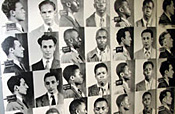Campus News
University Opens National Death Penalty Archive
(September 22, 2005)
 |
Sing Sing prisoners. From the Special Collections exhibit that includes Scott Christianson's book, "Condemned: Inside the Sing Sing Death House." |
For anyone interested in the history of capital punishment in America, the University's new National Death Penalty Archive (NDPA) is an unrivaled resource.
The archive, initiated by the Capital Punishment Research Initiative of the School of Criminal Justice, houses the records of scholars and organizations that focus on issues related to capital punishment.
Located in the Science Library's M.E. Grenander Department of Special Collections and Archives, the new archive officially opened Aug. 9 in a ceremony that featured leading national death penalty experts.
Distinguished Professor James Acker, who is co-director of the Capital Punishment Research Initiative (CPRI) with Charles Lanier at the School of Criminal Justice, noted that the archive is the only one in the nation that is exclusively dedicated to the death penalty.
"We are building a collection that will serve as a primary resource for historians, researchers, faculty, students and interested members of the public," said Lanier.
The keynote speaker at the opening was scholar Hugo Adam Bedau, whose papers are included in the archive. Bedau, professor emeritus at Tufts University, was co-author with his wife, Constance Putnam, and Michael Radelet of In Spite of Innocence: Erroneous Convictions in Capital Cases (1992). Radelet and Putnam were also in attendance.
In addition, the archive includes the William J. Bowers/Capital Jury Project Collection, containing some 1,200 interviews with jurors from more than 350 capital trials; the Alvin Ford Collection, the papers of a convicted murderer who went insane on death row; the Joe Ingle/Southern Coalition on Jails and Prisons Papers, a group formed to advocate for alternatives to the death penalty; the papers of Ernest van den Haag, a conservative commentator who was among America's foremost proponents of the capital punishment; and the Rick Halperin Collection, featuring news coverage of death penalty issues from across the nation in the 1970s and 1980s.
Other collections include the records of hearings before the New York State Assembly Committee earlier this year that sought public input on capital punishment as part of a process to consider reinstituting a death penalty law in New York after the law was declared unconstitutional by the New York Court of Appeals.
One of the exhibits on display at the opening featured Condemned: Inside the Sing Sing Death House, a book by historian and author Scott Christianson. Between the 1890s and 1963, 613 men and women were executed in the electric chair at Sing Sing. One photo in the exhibit showed the mug shots of the condemned.
UAlbany undergraduate and graduate students are assisting with the development of the archive.
Lisa Sacco, a Ph.D. student in the School of Criminal Justice, conducted interviews for the Abolitionist Oral History Project, a collection of audio and video interviews with death penalty abolitionists, and related information.
"The death penalty is one of the most contentious issues in American jurisprudence
and culture, and I am proud that as one of the nation's top-ranked schools
for criminal justice, we continue to lead by bringing this collection to fruition," said
UAlbany President Kermit L. Hall.
